 Open Access
Open Access
ARTICLE
Neutrosophic Adaptive Clustering Optimization in Genetic Algorithm and Its Application in Cubic Assignment Problem
1 School of Navigation and Shipping, Shandong Jiaotong University, Weihai, 264209, China
2 College of Transport and Communications, Shanghai Maritime University, Shanghai, 201306, China
3 School of Mathematics and Statistics, Zhaoqing University, Zhaoqing, 526061, China
4 School of Business, Shandong Normal University, Jinan, 250358, China
5 School of Civil and Environmental Engineering, Ningbo University, Ningbo, 315211, China
* Corresponding Author: Fangwei Zhang. Email:
(This article belongs to the Special Issue: Decision making Modeling, Methods and Applications of Advanced Fuzzy Theory in Engineering and Science)
Computer Modeling in Engineering & Sciences 2023, 134(3), 2211-2226. https://doi.org/10.32604/cmes.2022.022418
Received 09 March 2022; Accepted 30 May 2022; Issue published 20 September 2022
Abstract
In optimization theory, the adaptive control of the optimization process is an important goal that people pursue. To solve this problem, this study introduces the idea of neutrosophic decision-making into classical heuristic algorithm, and proposes a novel neutrosophic adaptive clustering optimization thought, which is applied in a novel neutrosophic genetic algorithm (NGA), for example. The main feature of NGA is that the NGA treats the crossover effect as a neutrosophic fuzzy set, the variation ratio as a structural parameter, the crossover effect as a benefit parameter and the variation effect as a cost parameter, and then a neutrosophic fitness function value is created. Finally, a high order assignment problem in warehouse management is taken to illustrate the effectiveness of NGA.Keywords
In optimization theory, heuristic algorithms are mainly used to deal with Non-deterministic Polynomial (NP) problems. The biggest characteristic of NP problems is that it is not certain whether the answer can be found in polynomial time, but it can be verified in polynomial time. In the process of solving NP problems, the control of optimization quality is the key to determining the quality of a given algorithm. Especially, with the rapid development of society, NP problems cover more and more data, and the monitoring of the optimization process is more and more important. Under the aforementioned background, to ensure the quality of the optimization model, this study introduces the neutrosophic fuzzy thought into the heuristic algorithm and achieves good results. For the convenience of introduction, this study presents a neutrosophic adaptive clustering optimization thought in a novel neutrosophic genetic algorithm (NGA).
Generally, a genetic algorithm (GA) includes four steps, i.e., coding, selection, crossover, and mutation. In the selection of individuals in each generation, the classical GA is usually mechanical to determine the proportion of crossover and variation, and cannot adjust the aforementioned proportion adaptively according to the quality of individuals in each generation. To solve this problem, this study creatively introduces the neutrosophic fuzzy thought into GA, makes an intelligent transformation of the GA, and creatively proposes a neutrosophic genetic algorithm (NGA). For convenience, some related works on neutrosophic fuzzy sets (NFSs), GA, utility function, and assignment problems are introduced in the following subsection.
In the past decade, scholars have done lots of exploratory research in the field of NFSs. Sodenkamp et al. [1] proposed a novel method to deal with independent multi-source information in the group decision-making process by using single-valued NFSs. Long et al. [2] proposed a fuzzy clustering method using a kind of neutrosophic association matrix. In the same year, Zavadskas et al. [3] proposed a hedonic shopping rent valuation model by the one-to-one neuro-marketing meth. Afterward, Rashno et al. [4] proposed a novel clustering model based on NFS theory, whose main role is to calculate the boundary points in the clustering process. Abdel-Basset et al. [5] developed an evaluation method under uncertainty of linear time-cost tradeoffs by using NFSs. In the same year, Son et al. [6] proposed a kind of novel optimal control method in a neutrosophic fuzzy environment by using granular computing. Thereafter, Xu et al. [7] proposed a novel decision-making method based on TODIM and TOPSIS with multi-valued NFSs. Rahman et al. [8] introduced a kind of parameterized NFS, and applies it to decision-making fields. These two types of research combine the NFS with the decision-making theory tightly.
As one of the most classical heuristic algorithms, GA has been a concerned by scholars and has made great improvement in the past decade. Andrade et al. [9] introduced a novel multi-parent biased random-key GA and a novel implicit path-relinking procedure. Thereafter, Wang et al. [10] analyzed the Boolean function from the viewpoint of geometric space and proposed a novel GA to construct objective space with high nonlinearity. Guijarro et al. [11] proposed a model that combined a data envelopment analysis model with a GA to handle sector restructuring problems. Su et al. [12] introduced a novel GA with a specific binary space partition tree, which showed good quality in solving eight benchmark problems, fault diagnosis problems, and hybridized with the molecular signatures’ selection problems. In the same year, Ahn et al. [13] put forward a GA for multi-objective feature selection. Koohestani [14] thought that crossover was a very important operator in a GA by which new individuals of the next generation realize time and time again. And then, it proposed a specific crossover operator to solve the problem of variable conversion in combinatorial optimization.
The latest studies regarding utility function have also been taken as foundations for this study. Greve et al. [15] proposed a utility function to calculate the exchange proportion of the monetary value of different products in a management system. Chun et al. [16] proposed a kind of product utility value based on the total performance index method. Meanwhile, a robust utility-based decision model is proposed by Hu et al. [17] to solve the fuzziness and inconsistencies in utility evaluation. Dias et al. [18] studied the generation of the utility function in the random multi-criteria acceptability analysis. This function described how rational consumers make spending decisions. Based on utility function, Niromandfam et al. [19] established the economic demand model of customer risk aversion behavior which considers the influence of incentive payment on power consumption. Mao et al. [20] proposed a comparison of regret and utility-based discrete choice modeling. Afterward, Abraham et al. [21] investigated the problem of utility calculation in wind power generation, hybridized with the main factors influencing utility calculation.
Moreover, some representative research regarding the assignment problem has also been reviewed. Due to the lack of research on the cubic assignment problem (CAP), attention has been paid to the research results on the quadratic assignment problem (QAP) for reference. Duman et al. [22] studied a kind of relative complex assignment problem in circuit board design and introduced a way to solve the given problem. Later, Xia [23] proposed a method using a continuation function to settle the QAP. Meanwhile, Zhang et al. [24] proposed two formula reduction problems for QAP, and studied the effect of constraint reduction hybridized with the effect of variable reduction in a sparse cost matrix. Hafiz et al. [25] proposed a novel probabilistic particle swarm optimization. In addition, Samanta et al. [26] introduced a novel viewpoint on QAP as double target-dependent position-oriented QAP. And then, by combining with the genetic and neighborhood search algorithm, the given problem is solved. Subsequently, Samanta et al. [27] admitted that the QAP was an NP-hard problem, and proposed a quick convergent artificial bee colony algorithm to solve it.
Based on extensive research and the aforementioned research results, this study combines the NFSs and GA organically. For convenience, the objectives and contributions of this study are introduced in the following.
1.2 Objectives and Contributions
In practice, it is hoped that the adopted algorithm is adaptively adjusted according to the specific NP problem to accelerate the optimization and avoid getting trapped into the local optimal solution. Based on the extensive investigation, this study holds that the key to solving the NP problem lies in using modern tools to deal with the multi-source uncertain information in the process of calculation. For example, classical GA includes initialization, individual evaluation, selection operation, crossover operation, mutation operation, and the judgment of termination conditions. Among them, the selection process encountered the most uncertain information, but also the most complex. To treat the encountered uncertainties in all kinds of information in the selection process scientifically, this study introduces neutrosophic thought into GA. Specifically, this study first selects the appropriate subject in the selection process. Then, around the selected subject, the uncertain information in the selection process is divided into three parts, i.e., the truth part, indeterminacy part, and falsity part. Thereafter, the utility function on NFSs is used to integrate the three types of information and calculate the selection proportion.
The main theoretical innovation of this study is to propose a novel NGA. The first characteristic of NGA is to extract the decision framework from GA and combine the optimization with decision-making theories organically. The second characteristic of this study is to calculate the selection proportion in the selection process by using a novel utility function. For convenience, some definitions of GA and NFSs are introduced below.
Definition 1 A GA is a kind of Heuristic algorithm to solve optimization problems of both constrained and unconstrained. By referring to the natural selection process in biology, the classical GA generates a population of feasible solutions (individuals) from generation to generation. In each step, the GA selects individuals randomly from the present population and uses them as parents to generate new individuals for the next generation. Time and time again, the population gets constantly approaching the ideal solution. Through summary and induction, the aforementioned statement can be expressed as
where represents the coding methods of individuals E represents the evaluation function of the fitness value of individuals,
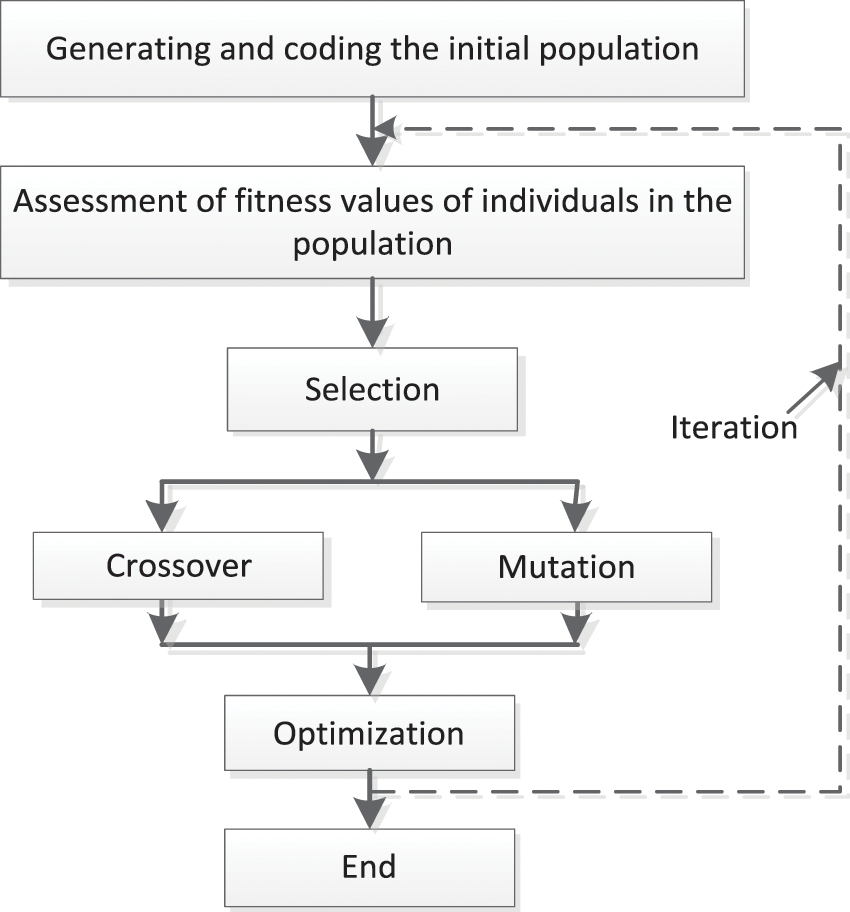
Figure 1: Classical GA process
In the following section, the concept of classical single-valued NFS is introduced. It is noteworthy that this kind of fuzzy set has been widely used in decision making, image process, and medical diagnosis.
Definition 2 Assumes the space of points with a representative element in it denoted by
For convenience, the single-valued neutrosophic element is denoted as
In the following section, by using the proposed concepts and definitions, a novel NGA is proposed to solve the optimization problem in warehouse operation.
For the sake of convenience, in this following-up subsection, a kind of generalized utility function (GUF) and a specific utility function (UF) on single-valued neutrosophic sets (SVNSs) are introduced as follows.
Definition 3 Suppose a single-valued neutrosophic element on
Then, a kind of GUF on a is denoted as
where
It is noteworthy that
which indicates the proportion of definite information in
Definition 4 Suppose a is a single-valued neutrosophic fuzzy number on
Then, specific UF on is denoted as
where is a positive integer which represents the characteristic of users. In industrial production, when users pay more attention to benefits, the parameter
Especially, when
When
Based on the above analysis, it gets that is suitable for the users who are benefit first and optimistic, while suitable for the users who are cost-effective and conservative. Moreover, some important properties on are introduced as follows.
Theorem 1 Suppose
and
Theorem 2 Suppose
Theorem 3 Suppose
Theorem 3 indicates that
3.2 NGA for Warehouse Operation
Based on combining GA and NFS theories, a novel heuristic algorithm is proposed. For convenience, the benefit-oriented objective is taken as the research object, i.e., the larger the objective function value is, the better the feasible solution. In the following, the studied problem will be introduced firstly.
(i) Problem introduction
In the production activities of enterprises, there are a variety of attributes to be considered, such as risk, efficiency, cost, environmental protection, etc. Suppose that there are n objects
Then, the optimization problem is expressed as
In theories, when n is large enough, it is difficult to find accurate feasible solutions for Eq. (4) in a limited time. Then, the existing heuristics algorithms seek near-optimal solutions at a low cost, where GA is one of these heuristic algorithms.
(ii) Analysis of adaptive clustering
To solve the aforementioned problem using classical GA, one important step is to divide the newly generated offspring of each generation into two parts, where one part is to make the crossover, and the other part is to make mutation. Usually, the criterion of this division is the order of fitness function values of the individuals of the same generation. However, there is a lot of uncertain information which is related to the proportion of division. In classical GA, the proportion is often fixed, which limits the environmental applicability of the classical GA. Furthermore, when the optimization problem changes, it cannot improve the optimization by adaptive adjustment of the proportion. Based on the aforementioned analysis, this study introduces neutrosophic thought to handle the uncertain information in the selection process, and then presents a novel method to adjust the division proportion according to the optimal environment. To illustrate the neutrosophic thought better, the iterative process of individuals between different generations please see Fig. 2.
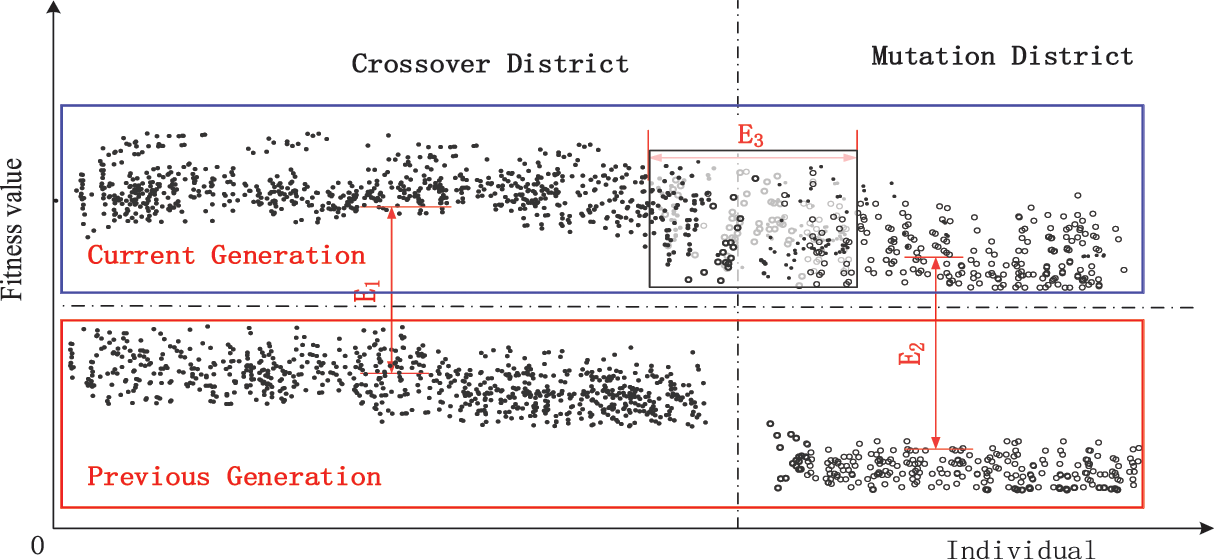
Figure 2: Iteration of individuals from the previous generation to the current generation
As illustrated in Fig. 2, the iteration effect of individuals in the crossover region and the mutation region can be evaluated by many different measurement functions. For convenience, the two aforementioned effects are denoted as
Moreover, after one time crossover and mutation, it can be concluded by calculating the fitness function value that the next generation produced by individuals in the crossover area is not necessarily superior to the corresponding individuals in the mutation area. That is to say, some of the offspring of the individuals in the crossover zone go into the mutation zone, and some of the offspring of the individuals in the mutation zone go into the crossover zone. The penetration of the two parts of invidious into each other’s region reflects the unstructured characteristic of the region segmentation proportion. Let’s call it
Next, it takes the crossover region as the subject and the variation region as the object, and analyzes the obtained three parameters
Specifically, when
(iii) Specific steps of NGA
Based on the aforementioned analysis, and by combing NFSs and classical GA theories organically, the introduced model (Eq. (4)) is solved. Specific steps are as follows.
Step 1 Initialization. Set the number of iteration times as
Step 2 Individual evaluations. For any given feasible solution for Eq. (4), it gets a feasible function value
Step 3 Select operations. According to the values
where
Step 4 Crossover and mutation operations. By using certain crossover operators transferred to
Step 5 Fuzzification operations. The iteration effect of individuals in the crossover region and the mutation region is expressed as
and
respectively.
Meanwhile, denote
Then,
respectively. The aforementioned unstructured parameter is expressed as
where
Then, a neutrosophic fuzzy number subject to the effect of crossover is obtained as
Step 6 Iteration of the division proportion. By referencing Eq. (2), the utility function value of
Denote the iterated selection proportion as
where
Step 7 Denote
(iv) Supplement
To further explain the novel NGA model, some supplementary explanations are provided.
(1) In Step 5, Eqs. (5) and (6) are proposed to describe the iteration effect of the individuals in crossover district and mutation district, respectively. The essence of
(2) In Step 6, Eq. (9) is a generalized time-varying function of Eq. (2). By elementary algebra calculation, it gets
By Eq. (10), with the increase in time of iteration, the restriction on the crossover is tightened, and the support of mutation is strengthened, which achieves the scheduled planning.
(3) In Step 3, the threshold function is settled in
In this section, a CAP in a dangerous goods warehouse is introduced to verify the proposed NGA model. Assume that there are 14 inbound points to stocking in and 14 outbound points to stocking out. For convenience, the inbound point is denoted as
By field investigation, it gets
Denote the fixed cost for operation management per hour as
It is noteworthy that Eq. (11) is a positive objective function, i.e., negative cost, to be consistent with the optimization environment of this study.
4.2 Optimization Process Using NGA
By using the proposed NGA model, the introduced problem is solved. First of all, a series of parameters are provided. Specifically, it values that
Step 1 Set the number of iteration times as
Step 2 For any given feasible solution x for Eq. (11), it gets a feasible function value
Step 3 Denote
Step 4 By using certain crossover operator
Step 5 By using Eqs. (5) and (6), the iteration effect of individuals in the crossover region and the mutation region are obtained as
Step 6 For convenience, denote
Step 7 Denote
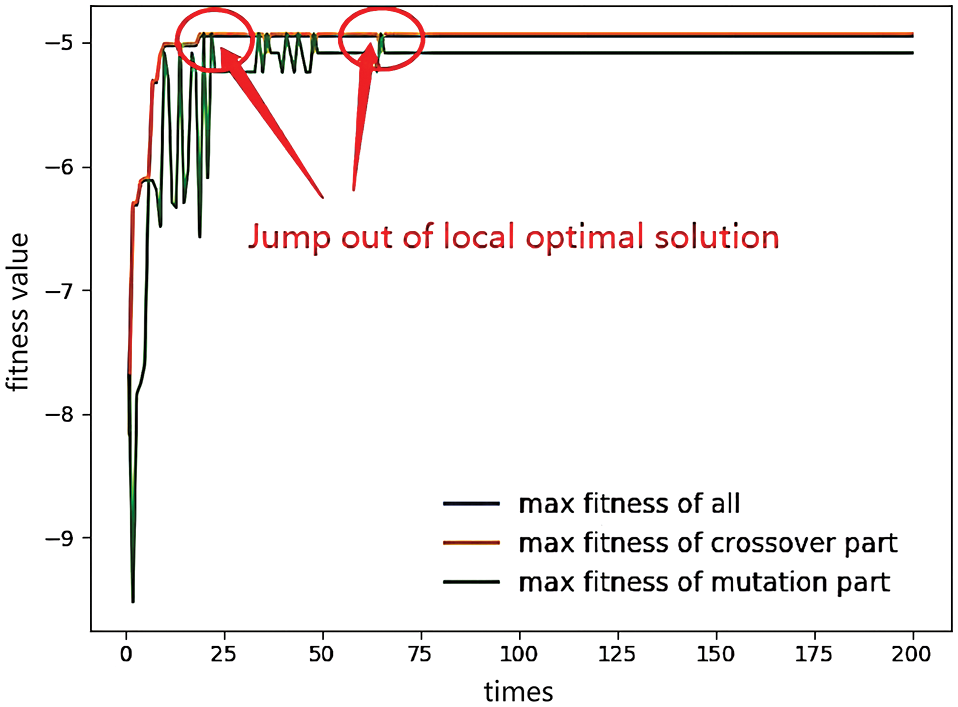
Figure 3: Optimal process
It is noteworthy that in the process of optimization, the NGA breaks through multiple locally optimal solutions by strengthening mutation. The most obvious one occurred in areas A and area B. This shows that the intelligent regulation of the proportion of crossover and mutation has achieved good results.
In this subsection, based on example calculation, the NGA and classical GA are compared. By comparison, some peculiar characteristics of NGA are described specifically.
(1) In NGA, the proportion of individuals in crossover and mutation districts is adjusted adaptively according to the effect of crossover and mutation. Correspondingly, in the classical GA, the proportion of crossover and mutation is fixed. Through the adaptive adjustment of the proportion of crossover and mutation, the NGA can strengthen crossover in the early stage of calculation to improve calculation efficiency, while strengthening mutation in the later stage of calculation to improve the ability to break through the local optimal solution. For more details on the change in the proportion, please see Fig. 4.
(2) The NGA highlights the overall optimization by using the mean function
(3) The NGA focuses on the handling of the uncertain information in the optimization process, and realizes the combination of the fuzzy utility function on NFS and GA. Correspondingly, the classical algorithm pays less attention to the information from the thought of Dialectics.
(4) By using the parameter n in Eq. (10), the NGA realizes the limited control of the optimization trend. Meanwhile, through
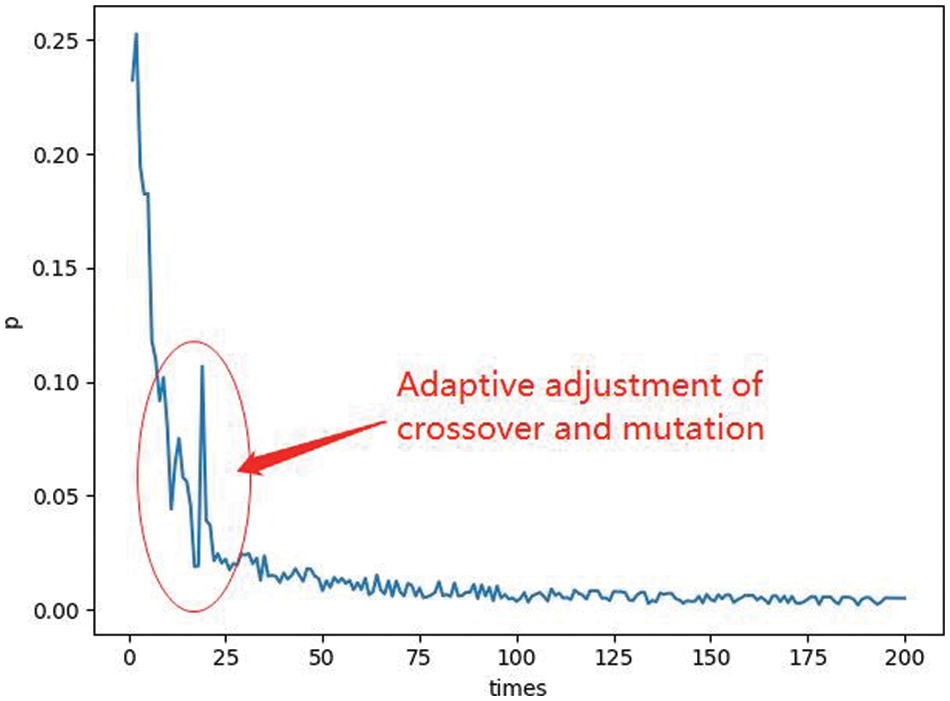
Figure 4: The proportion of crossover and mutation
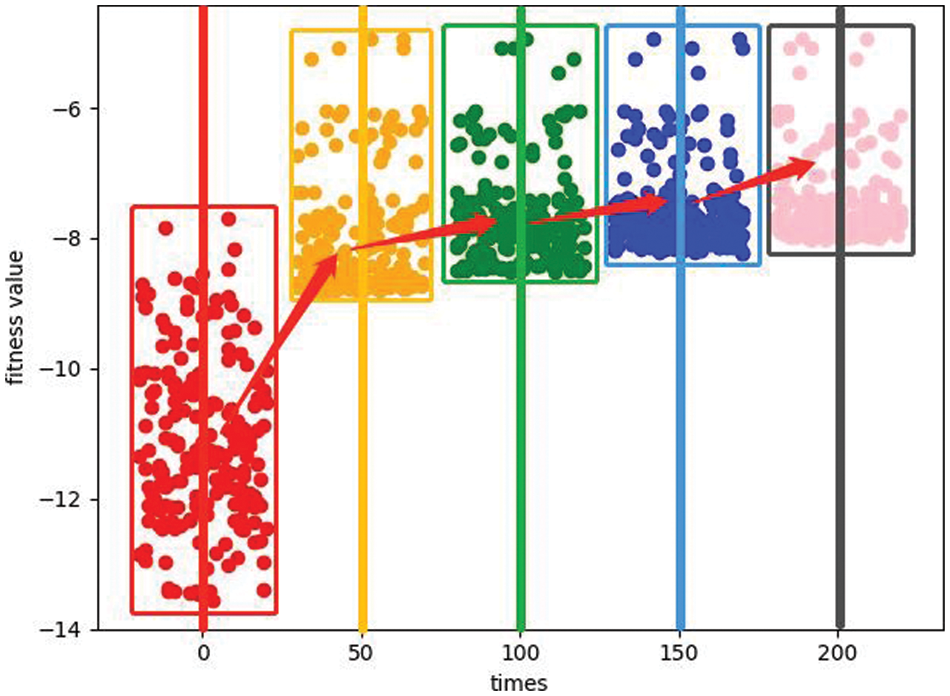
Figure 5: Quality improvement effect of invidious
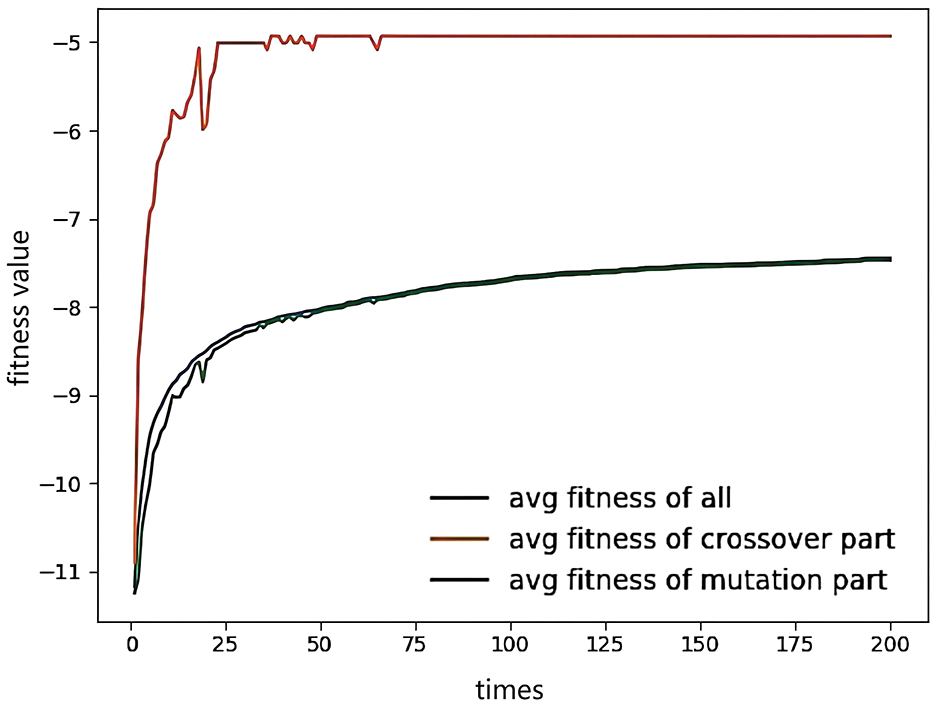
Figure 6: Average fitness function values of three kinds of invidious
In summary, the differences between the proposed NGA and classical GA are listed in Table 1.

In this study, a neutrosophic adaptive clustering optimization thought is introduced, and an NGA is also proposed. Generally, the classical GA is too mechanical to select individuals for crossover or variation adaptively. Contrastively, the proposed NGA can do this by using a novel neutrosophic adaptive clustering optimization algorithm. Furthermore, the characteristics of the proposed NGA are illustrated as follows.
Firstly, the novel NGA can adaptively adjust the proportion of crossover and mutation according to the crossover and mutation effects. By adaptively adjusting the mutation rate, the crossover can be strengthened in the early stage and the mutation can be strengthened in the later stage, which increases the ability of the proposed NGA to avoid the local optimal solution.
Secondly, in the crossover process, the crossover of the parent generation and the offspring production of the child generation uses the relative relation of position, which improves the computation speed.
Thirdly, the novel NGA treats the crossover effect as a fuzzy set, where the variation proportion is dealt with as a structural parameter, the crossover effect is dealt with as a benefit parameter and the variation effect is dealt with as a cost parameter. Thereafter, this study creatively proposes the fitness function value of the crossover effect by using utility theory on NFSs.
Fourthly, the threshold function is settled in NGA. Through the adopted threshold function, crossover and mutation can be realized generation by generation. In essence, the threshold function is a kind of protection for NGA. With the help of the proposed threshold function, the smooth operation of NGA is guaranteed.
Finally, this study takes the CAP as an example and compares it with the classical GA to verify the feasibility and effectiveness of the proposed NGA. Moreover, as revealed in this study, heuristic algorithms have the problem of dealing with uncertain information in the process of application, and there are some deficiencies in the automatic adjustment of optimization strategies. These deficiencies can be overcome by the combination of decision-making and optimization technologies. In the future, the latest decision-making technologies, such as intuitionistic fuzzy technology, hesitant fuzzy technology, and neutrosophic fuzzy technology, will be applied in optimization algorithms deeply.
Acknowledgement: The authors are thankful to the editors, and the anonymous reviewers for their constructive comments in improving this study.
Funding Statement: The work of the first author is partially supported by Shanghai Pujiang Program (2019PJC062), the Natural Science Foundation of Shandong Province (ZR2021MG003), the Research Project on Undergraduate Teaching Reform of Higher Education in Shandong Province (No. Z2021046), the National Natural Science Foundation of China (51508319), the Nature and Science Fund from Zhejiang Province Ministry of Education (Y201327642).
Conflicts of Interest: The authors declare that they have no conflicts of interest to report regarding the present study.
References
1. Sodenkamp, M. A., Tavana, M., Caprio, D. D. (2018). An aggregation method for solving group multi-criteria decision-making problems with single-valued neutrosophic sets. Applied Soft Computing, 71, 715–727. DOI 10.1016/j.asoc.2018.07.020. [Google Scholar] [CrossRef]
2. Long, H. V., Ali, M., Son, L. H., Khan, M., Tu, D. N. T. (2019). A novel approach for fuzzy clustering based on neutrosophic association matrix. Computers & Industrial Engineering, 127, 687–697. DOI 10.1016/j.cie.2018.11.007. [Google Scholar] [CrossRef]
3. Zavadskas, E. K., Bausys, R., Kaklauskas, A., Raslanas, S. (2019). Hedonic shopping rent valuation by one-to-one neuromarketing and neutrosophic PROMETHEE method. Applied Soft Computing Journal, 85, 105832. DOI 10.1016/j.asoc.2019.105832. [Google Scholar] [CrossRef]
4. Rashno, E., Minaei-Bidgoli, B., Guo, Y. H. (2020). An effective clustering method based on data indeterminacy in neutrosophic set domain. Engineering Applications of Artificial Intelligence, 89, 103411. DOI 10.1016/j.engappai.2019.103411. [Google Scholar] [CrossRef]
5. Abdel-Basset, M., Ali, M., Atef, A. (2020). Uncertainty assessments of linear time-cost tradeoffs using neutrosophic set. Computers & Industrial Engineering, 141, 106286. DOI 10.1016/j.cie.2020.106286. [Google Scholar] [CrossRef]
6. Son, N. T. K., Dong, N. P., Long, H. V., Son, L. H., Khastan, A. (2020). Linear quadratic regulator problem governed by granular neutrosophic fractional differential equations. ISA Transactions, 97, 296–316. DOI 10.1016/j.isatra.2019.08.006. [Google Scholar] [CrossRef]
7. Xu, D., Peng, L. (2021). An improved method based on TODIM and TOPSIS for multi-attribute decision-making with multi-valued neutrosophic sets. Computer Modeling in Engineering & Sciences, 129(2), 907–926. DOI 10.32604/cmes.2021.016720. [Google Scholar] [CrossRef]
8. Rahman, A. U., Saeed, M., Alodhaibi, S. S., Khalifa, H. A. E. (2021). Decision making algorithmic approaches based on parameterization of neutrosophic set under hypersoft set environment with fuzzy, intuitionistic fuzzy and neutrosophic settings. Computer Modeling in Engineering & Sciences, 128(2), 743–777. DOI 10.32604/cmes.2021.016736. [Google Scholar] [CrossRef]
9. Andrade, C. E., Toso, F. R., Gonçalves, J. F., Resende, M. G. C. (2019). The multi-parent biased random-key genetic algorithm with implicit path-relinking and its real-world applications. European Journal of Operational Research, 289(1), 17–30. DOI 10.1016/j.ejor.2019.11.037. [Google Scholar] [CrossRef]
10. Wang, Y., Zhang, Z. Q., Zhang, L. Y., Feng, J., Gao, J. et al. (2020). A genetic algorithm for constructing bijective substitution boxes with high nonlinearity. Information Sciences, 523, 152–166. DOI 10.1016/j.ins.2020.03.025. [Google Scholar] [CrossRef]
11. Guijarro, F., Martínez-Gómez, M., Visbal-Cadavid, D. (2020). A model for sector restructuring through genetic algorithm and inverse DEA. Expert Systems with Applications, 154(15), 113422. DOI 10.1016/j.eswa.2020.113422. [Google Scholar] [CrossRef]
12. Su, Y. S., Guo, N., Tian, Y., Zhang, X. Y. (2020). A non-revisiting genetic algorithm based on a novel binary space partition tree. Information Sciences, 512, 661–674. DOI 10.1016/j.ins.2019.10.016. [Google Scholar] [CrossRef]
13. Ahn, G., Hur, S. (2020). Efficient genetic algorithm for feature selection for early time series classification. Computers & Industrial Engineering, 142, 106345. DOI 10.1016/j.cie.2020.106345. [Google Scholar] [CrossRef]
14. Koohestani, B. (2020). A crossover operator for improving the efficiency of permutation-based genetic algorithms. Expert Systems with Applications, 151, 113381. DOI 10.1016/j.eswa.2020.113381. [Google Scholar] [CrossRef]
15. Greve, T., Teng, F., Pollitt, M. G., Strbac, G. (2018). A system operator’s utility function for the frequency response market. Applied Energy, 231, 562–569. DOI 10.1016/j.apenergy.2018.09.088. [Google Scholar] [CrossRef]
16. Chun, Y. Y., Lee, K. M., Lee, J. S., Lee, J. Y., Lee, M. H. et al. (2018). Identifying key components of products based on consumer-and producer-oriented ecodesign indices considering environmental impacts, costs, and utility value. Journal of Cleaner Production, 198, 1031–1043. DOI 10.1016/j.jclepro.2018.07.035. [Google Scholar] [CrossRef]
17. Hu, J., Bansal, M., Mehrotra, S. (2018). Robust decision making using a general utility set. European Journal of Operational Research, 269, 699–714. DOI 10.1016/j.ejor.2018.02.018. [Google Scholar] [CrossRef]
18. Dias, L. C., Vetschera, R. (2019). On generating utility functions in stochastic multicriteria acceptability analysis. European Journal of Operational Research, 278, 672–685. DOI 10.1016/j.ejor.2019.04.031. [Google Scholar] [CrossRef]
19. Niromandfam, A., Yazdankhah, A. S. (2020). Modeling demand response based on utility function considering wind profit maximization in the day-ahead market. Journal of Cleaner Production, 251(1), 119317. DOI 10.1016/j.jclepro.2019.119317. [Google Scholar] [CrossRef]
20. Mao, B. Q., Ao, C. L., Wang, J. X., Sun, B. S., Xu, L. S. (2020). Does regret matter in public choices for air quality improvement policies? A comparison of regret-based and utility-based discrete choice modelling. Journal of Cleaner Production, 254(1), 120052. DOI 10.1016/j.jclepro.2020.120052. [Google Scholar] [CrossRef]
21. Abraham, A., Hong, J. R. (2019). Dynamic wake modulation induced by utility-scale wind turbine operation. Applied Energy, 257(1), 114003. DOI 10.1016/j.apenergy.2019.114003. [Google Scholar] [CrossRef]
22. Duman, E., Or, I. (2007). The quadratic assignment problem in the context of the printed circuit board assembly process. Computers & Operations Research, 34, 163–179. DOI 10.1016/j.cor.2005.05.004. [Google Scholar] [CrossRef]
23. Xia, Y. (2010). An efficient continuation method for quadratic assignment problems. Computers & Operations Research, 37, 1027–1032. DOI 10.1016/j.cor.2009.09.002. [Google Scholar] [CrossRef]
24. Zhang, H. Z., Beltran-Royo, C., Constantino, M. (2010). Effective formulation reductions for the quadratic assignment problem. Computers & Operations Research, 37, 2007–2016. DOI 10.1016/j.cor.2010.02.001. [Google Scholar] [CrossRef]
25. Hafiz, F., Abdennour, A. (2016). Particle swarm algorithm variants for the quadratic assignment problems-A probabilistic learning approach. Expert Systems with Applications, 44, 413–431. DOI 10.1016/j.eswa.2015.09.032. [Google Scholar] [CrossRef]
26. Samanta, S., Philip, D., Chakraborty, S. (2018). Bi-objective dependent location quadratic assignment problem. Formulation and solution using a modified artificial bee colony algorithm. Computers & Industrial Engineering, 121, 8–26. DOI 10.1016/j.cie.2018.05.018. [Google Scholar] [CrossRef]
27. Samanta, S., Philip, D., Chakraborty, S. (2019). A quick convergent artificial bee colony algorithm for solving quadratic assignment problems. Computers & Industrial Engineering, 137, 106070. DOI 10.1016/j.cie.2019.106070. [Google Scholar] [CrossRef]
Cite This Article
 Copyright © 2023 The Author(s). Published by Tech Science Press.
Copyright © 2023 The Author(s). Published by Tech Science Press.This work is licensed under a Creative Commons Attribution 4.0 International License , which permits unrestricted use, distribution, and reproduction in any medium, provided the original work is properly cited.


 Submit a Paper
Submit a Paper Propose a Special lssue
Propose a Special lssue View Full Text
View Full Text Download PDF
Download PDF Downloads
Downloads
 Citation Tools
Citation Tools